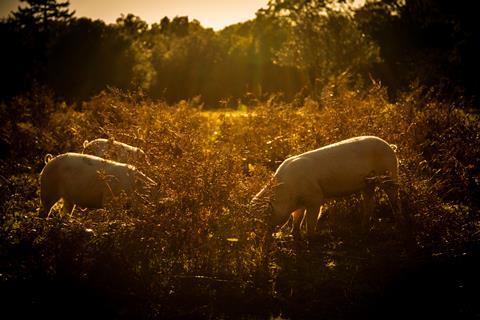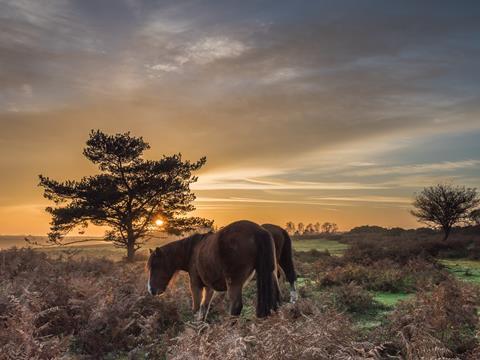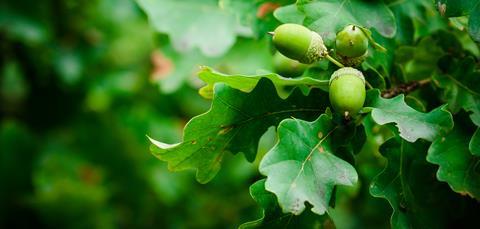Ben Valsler
This week, how pannage with pigs protects ponies, with Mike Freemantle.
Michael Freemantle
Last October, my wife and I were driving through the New Forest National Park when three not-so-little white pigs ambled across the road in front of us heading into the woods. We parked the car to investigate and found them beneath the boughs of some ancient oak trees. There they were with their snouts pressed to the ground gorging on fallen acorns. They totally ignored us.

The release of livestock pigs to wander freely in a forest is known as pannage. In the New Forest, the practice dates back to the time of William the Conqueror who founded the forest as a royal hunting ground in 1079. The pannage season in the forest lasts for about 60 days in autumn. It enables pigs to feed on green acorns, chestnuts and beech tree nuts. In the 19th century, up to 6,000 pigs were turned out each season. Nowadays, the number ranges from 200 to 600 annually.
Pannage has two major functions. First, it fattens up pigs for slaughter and salting before the winter. Second, green acorns are notably toxic to the New Forest ponies and cattle that roam freely throughout the forest. In most years, ten to thirty livestock animals die from acorn poisoning, but when there is a glut of acorns, it can be as high as 100 or more.
‘Clusters of pony deaths certainly appear to be associated with autumns when gales bring down large quantities of green acorns,’ observed ecologist Colin Tubbs in his book on the New Forest, published in 1986.

Although some horses acquire a taste for acorns and even search for them, most avoid them, especially if there is plenty of other forage available. Acorn poisoning can cause lesions in the throat, stomach and other parts of the gastrointestinal tract resulting in diarrhea, bloody urine, dehydration, weight loss, depression and other symptoms. It can also lead to kidney failure and liver damage. The susceptibility to acorn poisoning, however, varies from horse to horse. For cows, the poison is known to concentrate in milk affecting calves whereas older cows rarely become ill from eating acorns.
Similarly, bears and deer, like pigs, can consume and indeed thrive on acorns without any ill effects. The nuts are highly nutritious, containing vitamins, minerals, carbohydrates, proteins and fats. Surprisingly, acorns are toxic to red squirrels but not to grey squirrels.
So what causes acorn poisoning and why are some animals susceptible to it and others not? One of the main culprits is tannic acid. This is present in relatively high concentrations in green acorns. The acid binds to the minerals that initiate the enzyme activity required for germination. It therefore delays germination until the nuts turn brown after falling to the ground. The tannic acid level decreases in the process eventually allowing the acorns to sprout.
Tannic acid is a type of polyphenolic compound known as a gallotannin. Each gallotannin molecule has a central glucose or quinic acid core consisting of a ring of six carbon atoms attached to hydroxyl groups. Two or more of these groups are bound to gallic acid moieties. The number of gallic acid moieties in a tannic acid molecule ranges from two to twelve depending on the plant source.
Gallotannins are hydrolysable tannins. They are soluble in water and decompose in the presence of acids, alkalis and certain types of bacteria to form gallic acid and other products.
Research on the impact of acorns on the digestive system of pigs indicates that a tannic acid-binding protein in their saliva prevents the acid breaking down into gallic acid and the other toxic metabolites. The exact nature of acorn poisoning is unclear, however, although it seems that animals such as New Forest ponies are unable to bind the tannic acid in the acorns. When the nuts are digested, the acid irritates the gastrointestinal tract and, when it gets into the stomach, either gastric juices or bacteria, or possibly both, break it down into the toxins that damage the gut, liver and kidneys.

Unfortunately, there is no specific antidote for acorn poisoning, so prevention is vitally important. For cattle and horses, this can entail providing more palatable feeds and fencing off oak trees during autumn. But for the ponies that roam freely in the New Forest, there is another autumnal solution: pigs and pannage.
Ben Valsler
That was Mike Freemantle with tannic acid, green acorns and hungry pigs. Next week, yet another compound with pandemic-stopping potential: Favipiravir. This was requested by Jeff Silver in San Francisco back in April, and has a chequered history as an influenza medication, but just this week has shown positive results in a clinical trial against covid-19 in India. Join us next week to find out more.
Until then, find the podcast archive at chemistryworld.com/podcasts, and get in touch if you, like Jeff, have any compounds to suggest. Email chemistryworld@rsc.org, or tweet @chemistryworld. I’m Ben Valsler, thanks for listening.
Additional information
Theme: Opifex by Isaac Joel, via Soundstripe
Additional music: Meadow sanctuary and Hidden forest by Outside the Sky, via Soundstripe














No comments yet